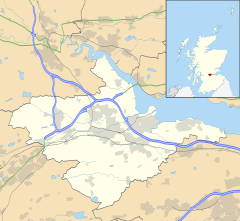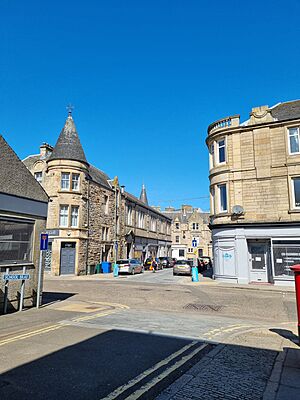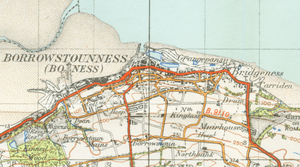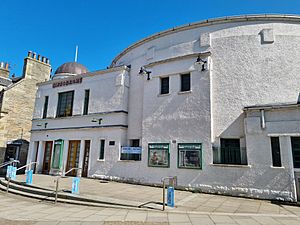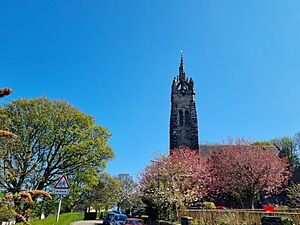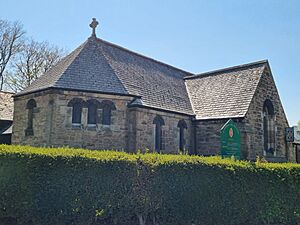Bo'ness facts for kids
Quick facts for kids Bo'nessBorrowstounness
|
|
|---|---|
 A view over the town looking north towards the Firth of Forth |
|
| Area | 2.3 sq mi (6.0 km2) |
| Population | 14,840 (2020) |
| • Density | 6,452/sq mi (2,491/km2) |
| OS grid reference | NS998816 |
| • Edinburgh | 16.9 mi (27.2 km) |
| • London | 343 mi (552 km) |
| Council area | |
| Lieutenancy area |
|
| Country | Scotland |
| Sovereign state | United Kingdom |
| Post town | BO'NESS |
| Postcode district | EH51 |
| Dialling code | 01506 |
| Police | Central Scotland |
| Fire | Central Scotland |
| Ambulance | Scottish |
| EU Parliament | Scotland |
| UK Parliament |
|
| Scottish Parliament |
|
| Website | falkirk.gov.uk |
Borrowstounness, usually called Bo'ness (/boʊˈnɛs/ boh-NESS), is a town and former seaport in Scotland. It sits on the south bank of the Firth of Forth, which is an estuary (where a river meets the sea). Historically, Bo'ness was part of West Lothian county. Today, it is in the Falkirk council area. It is about 17 miles (27 km) northwest of Edinburgh and 6.75 miles (10.9 km) east of Falkirk. In 2011, about 15,100 people lived in Bo'ness.
For many years, Bo'ness was a busy industrial town. People worked in coal mining, making salt, and producing pottery. Its location by the Forth River made it an important port during the Industrial Revolution. However, since the late 1900s, many industries have closed. The coal mine shut down in 1982. Now, the waterfront area is mostly used for fun activities. Still, some industries remain, like an ironworks and a timberyard/sawmill. The town centre has many old, important buildings and is a special conservation area. Bo'ness is also home to the Museum of Scottish Railways and a local motor museum.
Contents
What's in a Name?
The name Borrowstoun comes from an old English word meaning "Beornweard's farm." This was a small village a bit inland from the coast. The word ness means "headland" or "point of land." This helps tell the difference between the inland village and the coastal town. The shorter name Bo'ness started being used in the 1700s.
Bo'ness Through Time
Roman History in Bo'ness
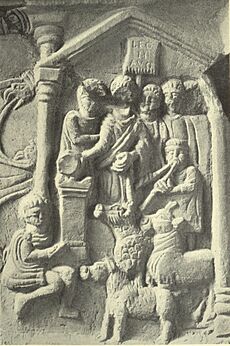
Bo'ness has strong connections to the Roman Empire. It marks the eastern end of the Antonine Wall. This wall stretched all the way across Scotland, from Bo'ness in the east to Old Kilpatrick in the west. The Antonine Wall was made a UNESCO World Heritage Site in 2007. You can still see the remains of a Roman fort at Kinneil House in the west of Bo'ness.
Roman objects, some with writing on them, have been found in the eastern part of the town at Carriden. A Roman fort called Veluniate once stood where Carriden House is now. It's even said that stones from the fort were used to build the mansion house.
Over the years, farmers have found many Roman items. One famous find is the Bridgeness Slab. Many of these items are now in the National Museum of Scotland or the Hunterian Museum in Glasgow. A copy of the Bridgeness Slab was put up in Kinningars Park in 2012. Other Roman sites have been found nearby at Muirhouses and Kinglass.
Trade and Industry
Bo'ness has been a recognized port since the 1500s. Coal was shipped from Bo'ness to supply Edinburgh Castle as early as 1548. A harbour was officially allowed by law in 1707. The harbour was built in stages during the 1700s and later got a dry dock in 1881. This dry dock was designed by engineers Thomas Meik and Patrick Meik.
The port was very busy, especially for moving coal. But it closed in 1959 because of too much mud in the water and the decline of coal mining. There are ideas to make the docks into a marina (a place for boats), but these plans are on hold. Bo'ness was given the right to collect taxes on exports in 1672. A large Customs House for the harbour was built in 1880. It is now private homes.
Bo'ness has been a site for coal mining since medieval times. Clay was also mined on a smaller scale. Along the shore, people made salt by boiling seawater over coal fires. The ruins of old fish storage houses show that commercial fishing used to be important here. The town also had several large potteries. One famous product was black "wally dugs" (ceramic dogs) that often sat in pairs on fireplaces. Metalworking is still done in Bo'ness.
Kinneil Colliery was a big coal mine on the west side of town. At its busiest, it employed over 1,200 people. The mine started in the late 1800s and grew a lot after 1951. It even connected to another mine, Valleyfield Colliery, through a tunnel under the Forth. The mine closed in 1982 because of difficult ground conditions. Today, the area above ground is a nature reserve that people can visit.
In the 1890s, when the town bought land for the Bo'ness Town Hall and park, Bo'ness was doing very well. The Town Hall and library plans were approved in 1902. The building officially opened on September 14, 1904.
In the 1900s, Bo'ness was one of several Scottish ports that took apart old ships. This was called the shipbreaking industry. The shipbreaking yard operated until about 1970. Large ships would be brought to the shore at high tide and driven as far up the beach as possible to be taken apart.
The Bo'ness Journal and Linlithgow Gazette was a local newspaper. Its offices were in a building built in 1884, which is now a listed historic building.
Economy and Famous Places
Ballantine Bo'ness Iron Company is an ironworks company in Bo’ness. It started in 1856. This company has made iron parts for many bridges in the UK. This includes the decorative panels of Westminster Bridge and North Bridge in Edinburgh. In 2019, the company made new ironwork for the roof of the Palace of Westminster and Elizabeth Tower. Another industry in town is Walker timberyard and sawmill, located by the Forth River.
Many people who live in Bo'ness work at the Ineos petrochemical facility (formerly BP) in nearby Grangemouth.
Kinneil House is a historic house west of Bo'ness. It is looked after by Historic Scotland. It is in a public park that also has a part of the Roman Antonine Wall. Inside the grounds of Kinneil House, you can find the ruins of a small cottage where James Watt worked on his first steam engine ideas.
Dymock's Building is a very old merchant's house from the 1600s. It was restored in the late 1990s and is now used as social housing, divided into 8 homes.
Culture and Community
Community Life and Fun Things to Do
Bo'ness is mostly a town where people live and then travel to work in places like Edinburgh, Glasgow, or Falkirk. Today, fun things to do in Bo'ness include the Bo'ness & Kinneil Railway, the Birkhill Fireclay Mine, and the local motor museum. Kinneil House, built by the powerful Hamilton family in the 1400s, is on the western edge of town.
Bo'ness is also home to the recently updated Hippodrome Cinema. It is the oldest movie theatre in Scotland. The Hippodrome was built in 1912. The Bo'ness Children's Fair Festival is a yearly event that still happens today.
Bo'ness also has its own theatre called The Barony Theatre. It used to be a primary school. Each year, their group, 'The Barony Players,' puts on popular plays. They also host other theatre groups.
The town's war memorial is on a hill overlooking the Forth. It is a large granite obelisk (a tall, thin monument). It was officially revealed on July 12, 1924. Later, plaques were added after the Second World War.
The current Bo'ness library is in a restored building from the early 1700s. It used to be a tavern. The library moved there in 1980.
Churches in Bo'ness
There are several churches in Bo'ness. These include Bo'ness Old Kirk, Carriden Parish Church, St Andrew's Parish Church, Craigmailen United Free Church, St. Catharine's Episcopal Church, Bo'ness Apostolic Church, Bo'ness Baptist Church, The Bo'ness Salvation Army, and St. Mary of the Assumption Roman Catholic Church.
Sports in Bo'ness
Bo'ness has a football club called Bo'ness United. There are also ladies' and under-16s teams. The football ground was damaged by a fire in June 2019.
Bo'ness Academy has a rugby team. A new rugby club, Bo'ness RFC, started in 2011. The Bo'ness Cycling Club was restarted in 2010 as Velo Sport Bo'ness. Jim Smellie, a famous local cyclist, won the Scottish Cycling Champion title 11 times. Some of his trophies can be seen at Kinneil House Museum.
Bo'ness has also been important in British motorsport. Hillclimb events were held on a course at the Kinneil estate from 1932 to 1966. These included the first-ever round of the British Hill Climb Championship. Since 2008, an annual Revival event for classic cars has been held on a similar course.
Parks and Green Spaces
Bo'ness has several parks and recreation areas. Douglas Park is one of the largest. It offers views across the River Forth and has a children's play area and football fields. Glebe Park is a smaller park in the town centre next to Bo'ness Town Hall. It has a Bandstand built in 1902.
Schools in Bo'ness
Bo'ness has one secondary school, Bo'ness Academy. There are five primary schools: Kinneil, Deanburn, Bo'ness Public School, St Mary's, and the Grange School.
Famous People from Bo'ness
- George Baird, a minister
- Euan Morton, an actor and singer
- Henry Cadell, a geologist
- George Denholm, a fighter pilot in the Battle of Britain
- Jo Gibb, an actor
- Gary Wales (actor), an actor who grew up in Bo'ness
- Christine Grant, an athletics director
- James Hamilton, 1st Lord Hamilton
- Margaret Kidd, an advocate
- Henrietta Elizabeth Marshall, a children's writer
- James Brunton Stephens, an Australian poet
- Harcus Strachan, a Canadian soldier who won the Victoria Cross
- William Young (1761–1847), from the Royal Navy
Images for kids
See also
 In Spanish: Bo'ness para niños
In Spanish: Bo'ness para niños


